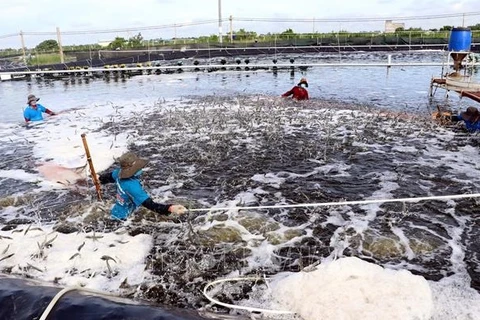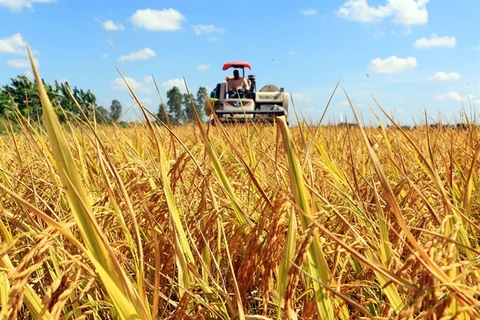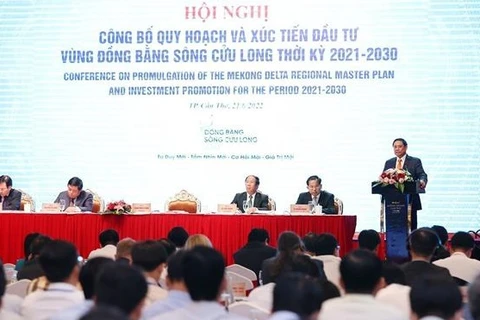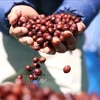Can Tho (VNA) - Protecting, embellishing and developing the natural ecosystem towards a people-centered green economic model is the premise for the sustainable development of the Mekong Delta towards green growth and climate change adaptation based on three economic-social-environmental pillars.
This is one of the strategic breakthroughs sketched out by Minister of Planning and Investment Nguyen Chi Dung for the development of the Mekong Delta a conference held in Can Tho city on June 21 to announce the Master Plan and investment promotion programme for the Mekong Delta in the 2021-2030 period, with the theme "Mekong Delta: New thinking - New vision - New opportunities - New values”.
Turning challenges into opportunities
According to Minister Dung, the Mekong Delta Regional Master Plan aims to concretise the new ways of thinking and visions set out in the country's socio-economic development strategy for the 2021-2030 period as well as the orientations and directions of the Party and State, thereby opening up new development opportunities and shaping the values for the region.
The Master Plan sets out orientations to turn challenges into opportunities. Specifically, the growth model will be transformed in the direction of increasing efficiency and value, with a focus on mobilising and effectively using human and scientific-technological resources. The regional economy will be promoted towards a green and circular economy. The energy industry will serve as a breakthrough and the services sector a pedestal.
The minister emphasised the change of mindset on food security, shifting from developing rice-based agriculture to aquaculture-fruit-rice farming to meet market demand.
He noted that by 2030, the Mekong Delta region will become a sustainable, dynamic and highly efficient agricultural economic centre of the country, region and the world based on concentrating investment resources on development corridors, locomotive development areas, and agricultural hubs identified in the master plan.
Infrastructure as a pedestal
To fulfil the above-mentioned goals, Minister Dung said that the master plan focuses on developing infrastructure to be a pedestal for socio-economic development and promoting regional linkages. Special attention will be paid to the development of transport infrastructure, especially routes connecting Ho Chi Minh City and the southeastern region.
By 2030, the Mekong Delta will build and upgrade 830 km of expressways, 4,000 km of national highways, four airports, 13 seaports, 11 clusters of passenger ports and 13 clusters of cargo ports.
According to Dung, the master plan focuses on developing an industrial-urban corridor from Can Tho to Long An that connects with Ho Chi Minh City, the southeastern region and a system of eight agricultural centres.
The whole region will expand trade with Ho Chi Minh City, the southeastern region and ASEAN, especially the countries of the Mekong Sub-region, based on changing the thinking on exploitation and use of water resources and focusing on preserving the landscape, ecology, culture, history, ethnicity, and rivers of the region.
Immediately after the master plan was approved, the ministry coordinated with other ministries, sectors and localities to develop schemes to realise it, focusing on four groups of tasks.
These tasks are developing a high-value and high-efficiency agricultural economy, developing a locomotive urban-industrial area, building a good living environment and an attractive destination, and managing and coordinating the implementation of the regional master plan.
Minister Dung revealed that in the 2021-2025 period, about 320 trillion VND (13.660 billion USD) of the State budget will be allocated to implement projects under the master plan, an increase of 23.3% compared to the previous five-year period.
The Mekong Delta has many comparative strengths, with its large natural land area of nearly 4 million sq. km (13% of the country’s total) and huge population (18 million, 19% of the country’s total). The region also makes up 12% of the national GDP; 700km of the coastal line and 360,000sq. km of the sea surface, and an exclusive economic zone connecting major sea lines.
The region has 2.5 million hectares of fertile land enriched by the Mekong River, making it the biggest agricultural production centre in Vietnam – making up 50% of rice output, 65% of aquaculture production, and 70% of fruits – fulfilling the mission of ensuring food security for the country.
The region also has strengths in renewable energy, year-round tourism, and other services./.
























